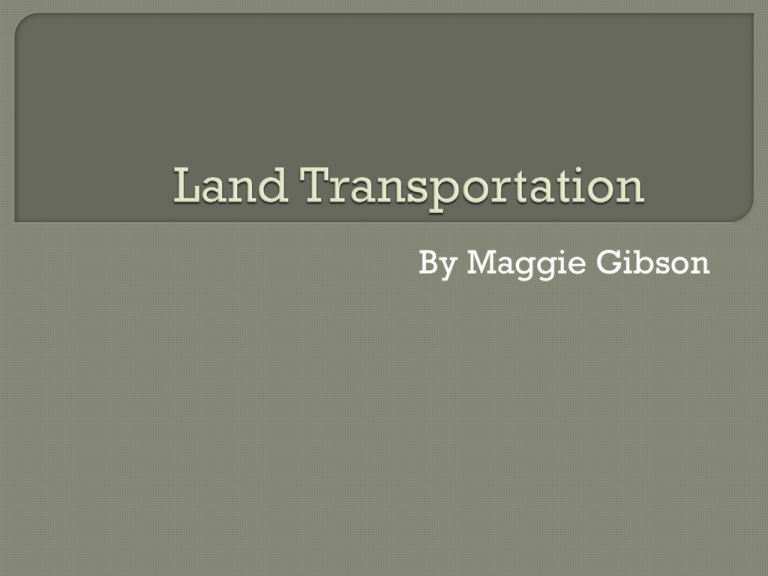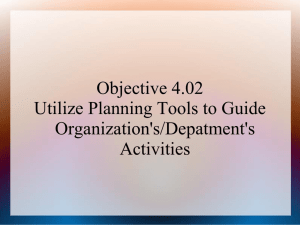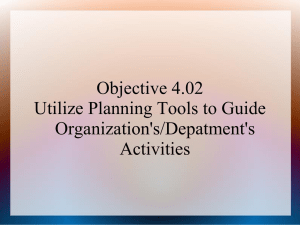Land Transportation Powerpoint
advertisement

By Maggie Gibson Transport activity. is closely linked with economic Some types of transport provide inputs to production in the form of commuting and business trips and by moving goods between producers and consumers. Other forms of transport help households carry out the activities they are interested in. (Proost, Stef and Kurt Van Dender. “WHAT SUSTAINABLE ROAD TRANSPORT FUTURE? TRENDS AND POLICY OPTIONS.” International Transport Forum, 2010. http://www.internationaltransportforum.org/jtrc/discussionpapers/DP201014.pdf) Income growth stimulates the demand for such transport and, together with the decrease in prices of car and air transport, has generated a strong increase in individual mobility in rich countries for all kinds of activities, including commuting, education, recreation, use of services, shopping, and tourism. (http://www.internationaltransportforum.org/jtrc/discussionpapers/DP201014.pdf) Public policy has largely accommodated – and sometimes inadvertently stimulated – these developments via its spatial planning and infrastructure capacity decisions, so that economic development in advanced economies has gone hand in hand with strongly growing transport volumes. (http://www.internationaltransportforum.org/jtrc/discussionpapers/DP201014.pdf) People and things have always had the need to move or be moved from one place to another. People have always looked for more comfortable or quicker ways to travel Different environments require different methods of transportation. Pelton, Christine "The Evolution of Transportation." The Evolution of Transportation. 22 Apr. 2010 EzineArticles.com. 20 Jun. 2013 <http://ezinearticles.com/?The-Evolution-of-Transportation&id=4158206>. Some vehicles travel on the ground, like a train. Some vehicles travel on top of the water, like a jet ski. Some even help people to travel under the water, like a submarine. People use other types of crafts to travel in the air. A hot air balloon is an interesting way to travel through the sky. Article Source: http://EzineArticles.com/4158206 Crafts such as rockets can help people to travel into space. Over the centuries, inventors designed machines or improved ways of traveling to move people faster and faster. Article source: http://ezinearticles.com/?The-Evolution-of-Transportation&id=4158206>. For our topic, though, we will focus, on vehicles that travel on land. http://www.factmonster.com/science/inve ntions/road.html http://alife.co.uk/essays/memetic_takeover/ A train is a vehicle that runs on tracks, or rails. Passenger trains may have many compartments for people to travel from one place to another. Freight trains carry cargo, or things. Different cars transport different types of items. Article Source: http://EzineArticles.com/4158206 Refrigerator cars transport food. Container cars need a crane to lift cargo in or out of the car. Tanker cars transport different types of liquids. Article Source: http://EzineArticles.com/4158206 • People sometimes use the term light rail to talk about trains that run on city streets. A trolley, also called a streetcar, is one type of light rail transportation. The first streetcars were pulled by horses or even people. Modern streetcars usually get their power from electricity. • Article source: http://ezinearticles.com/?The-Evolution-of-Transportation&id=4158206>. Video: http://www.youtube.com/watch?v=I-OYnsDp1Qg) • A subway is a light rail system of cars. A subway runs on the street and in underground tunnels. Many large cities have a network of subway tunnels. Article source: http://ezinearticles.com/?The-Evolution-of-Transportation&id=4158206>. (Video: http://www.alstom.com/us/products-andservices/transport/metros-light-rail-more/) Big trains have wheels that run on railroad tracks. They travel long distances between cities and towns. The first car on a train is the locomotive. The locomotive powers the train. The first trains used steams engines. Today, most trains get power from using gasoline or electricity. Article Source: http://EzineArticles.com/4158206 High-speed rail trains, sometimes called bullet trains, are electric trains that run faster than a regular train. These high speed rail systems also transport people in Germany, Korea, and Spain. The first countries to build and use the bullet train were France and Japan. Video: http://www.telegraph.co.uk/news/worldnews/asia/japan/10098065/Jap an-tests-310mph-bullet-train.html The monorail is another type of train. Most monorail systems run on a single rail. Some monorails are suspended. The train cars actually hang from the track. Video: http://www.youtube.com/watch?v=STRz0gjCMsw Article Source: http://EzineArticles.com/4158206 People drive and are passengers in motor vehicles in most places of the world. Motor vehicles have wheels and a motor. They can be driven on many different land surfaces. Cars, buses, and trucks allow people and things to travel to certain places. They can travel where boats and trains cannot go. Article Source: http://EzineArticles.com/4158206 Click here to see a video, “125 years of the Car—The History of Motoring” Made in Germany: http://www.youtube.com/watch?v=JKpw5Y vGjEQ Cars are vehicles used by people to get from one place to another. Combustion engines are often the power source for cars. This type of engine burns gasoline or diesel fuel to run. Some people are concerned that combustion engines are contributing to pollution in the air. Article Source: http://EzineArticles.com/4158206 Inventors have developed other types of power systems to make cars run. Electric cars have electric motors that run on batteries. Some cars use hydrogen to provide power. A hybrid car uses a combustion engine and battery power to make the car work. Article Source: http://EzineArticles.com/4158206 A micro-car, also called a bubble car, is very popular in countries outside of the United States. Auto makers designed the micro-car to use less gas. It is also economical because a small amount of material is necessary to build the car. Video: http://www.dailymotion.com/video/xh0t37_toyota-s-scioniq-microcar-for-north-america_auto Article Source: http://EzineArticles.com/4158206 Buses usually operate on a schedule. A passenger bus can carry people long distances. They travel between different cities and towns. A tour bus carries tourists or people on vacation. Some people charter, or rent, a bus for special purposes. Article Source: http://EzineArticles.com/4158206 Vehicle engineers designed trucks to carry materials of all kinds. Pickup trucks have a flat bed behind the passenger compartment. They can carry many things in the flat bed. Large trucks transport different kinds of heavier materials or equipment. They carry things to places where trains and boats cannot travel. An 18-wheeler is a very big truck. It has 18 separate wheels. Article Source: http://EzineArticles.com/4158206 Segway—Personal Transport Video: http://www.bing.com/videos/search?q=segway&view=detail&mid=E3C9281ECAE 6ECB15D2EE3C9281ECAE6ECB15D2E&first=0&FORM=NVPFVR Driverless Google car Video: http://www.bing.com/videos/search?q=google+car&view=detail&mid=C8B0 43CE788D23F052CBC8B043CE788D23F052CB&first=0&FORM=NVPFVR Driverless bus Video: http://www.bing.com/videos/search?q=driverless+bus&view=detail&mid=34 FEB172627215991D7C34FEB172627215991D7C&first=0&FORM=NVPFVR Air Pod Video: http://www.youtube.com/watch?v=0RBl1LFUQ4c Urban mobility http://www.youtube.com/watch?v=gHrl2P6QGYQ&NR=1&feature=endsc reen Evacuated Tube Transport http://www.youtube.com/watch?v=McpWcn-1RZU Interactive roadways http://www.youtube.com/watch?v=IBTx87xiscs Different kinds of vehicles http://www.youtube.com/watch?v=u_aPcPQ8mXU Travel anywhere on earth in 42 minutes http://www.youtube.com/watch?v=EapvQ3ALYJY Safety (Laynie Weaver’s Safety PPT) https://bay172.mail.live.com/default.aspx?rru=home&livecom=1#!/mail/ ViewOfficePreview.aspx?messageid=da6620f2-d9e2-11e2-a97800215ad735cc&folderid=00000000-0000-0000-0000000000000001&attindex=7&cp=-1&attdepth=7&n=1992507641 Infrastructure • Rail • Highways • Public transit Traffic control http://upload.wikimedia.org/wikipedia/en/5/57/M anual_on_Uniform_Traffic_Control_Devices_2003_c over.jpg It is clear that transport activities contribute to long-term problems concerning climate change, jeopardize the long-term availability of oil resources, so transport becomes a sustainability problem. (http://www.internationaltransportforum.org/jtrc/discussionpapers/DP201014.pdf) Aging bridges-- According to the Federal Highway Administration, more than 72,000 bridges across the country are in some sort of trouble. (http://www.pbs.org/newshour/bb/government_programs/july-dec08/infrastructure_10-20.html) Activity: Build a SWEEET Bridge: http://www1.cyfernet.org/actCYFAR/mom/02-08-Bridges/sweet-bridge.pdf Crowded highways It is estimated that by 2025, there will be 284 million operating light vehicles in the United States–44 million more than in 2009 (http://www.cargroup.org/assets/files/ami.pdf) Distracted drivers—How many of those millions more drivers will be distracted by cell phones or other devices as they drive? Less land for new transportation infrastructure due to expanding populations around the world. http://boxkauto.com/wp-content/uploads/2011/03/Giant-traffic-jam.jpg With continued urbanization and concentration of economic activity in ever larger metropolitan areas, congestion levels could become intolerable. (http://www.internationaltransportforum.org/jtrc/discussionpapers/DP201014.pdf) Levels of noise and air pollution remain problematic despite advanced emission control technology. Evidence suggests that this could be at least as important as the climate and energy resource problem (http://www.internationaltransportforum.org/jtrc/discussionpapers/DP201014.pdf) Various governmental agencies, each with its own agenda, may not agree on how to proceed with new transportation systems. More sharing of roadways between motor vehicles and bicycles: “Bicycle Culture by Design: Mikael Colville-Andersen at TEDxZurich:” http://www.youtube.com/watch?NR=1&v=pX8zZdLw7cs &feature=endscreen “TEDxPortland 2011 - Mia Birk - Pedaling Towards a Healthier Planet:” http://www.youtube.com/watch?v=V7ZhTaxL6T8 Less reliance on fossil-fuels • Biofuels • Biocoal (to replace coal in producing electricity for electric vehicles) • Hydrogen cells • TED Talks: Juan Enriquez: “Using biology to rethink the energy challenge” : http://www.ted.com/talks/juan_enriquez_wants_t o_grow_energy.html http://www.monarchrh.com/wp-content/uploads/2011/08/benefits-walking-community-ridge-hill1.jpg Development of energy-smart communities Video: http://www.youtube.com/watch?v=VGJt_YXIoJI New Urbanism replacing urban sprawl Shared Vehicles • Bicycles • Cars • Motorcycles • Segways rather than private By 2035, the number of vehicles on the road worldwide will almost double to 1.7 billion, according to the International Energy Agency (IEA). Philip LeBeau“Whoa! 1.7 Billion Cars on the Road by 2035.” CNBC. <http://www.cnbc.com/id/49796736>. The 1.1 billion automobiles in 2012 already average a set of new tires about every 2 years, or 2.2 billion tires annually. Those 2.2 billion tires consume over half of the earth's rubber production, which of course burns even more fuel. These numbers are set to rise sharply as the earth's population grows and countries like China and India continue to industrialize and grow their middle classes. “How Many Cars Are There In The World Today?” <http://www.rfidtires.com/how-many-cars-world.html> According to the IEA, look at the growth in vehicles per capita in China: * 2000: 4 vehicles per 1000 people. * 2010: 40 per 1000 people. * 2035: 310 per 1000 people For comparison, the U.S. Currently has 660 vehicles per 1000 people. Philip LeBeau“Whoa! 1.7 Billion Cars on the Road by 2035.” CNBC. <http://www.cnbc.com/id/49796736 Automakers have made growing in China a top priority. It has already passed the U.S. to become the number one auto market in the world. It won't be long until China dwarfs the U.S. in auto sales. Philip LeBeau“Whoa! 1.7 Billion Cars on the Road by 2035.” CNBC. <http://www.cnbc.com/id/49796736 India will also see explosive growth, going from 14 million cars today to an estimated 160 million cars 23 years from now. Philip LeBeau“Whoa! 1.7 Billion Cars on the Road by 2035.” CNBC. <http://www.cnbc.com/id/49796736 With so many vehicles rolling out worldwide, it raises a swirl of questions: How will countries curtail emissions? What will this increased demand mean for gas prices? Will electric and hybrid cars take off? Philip LeBeau“Whoa! 1.7 Billion Cars on the Road by 2035.” CNBC. <http://www.cnbc.com/id/49796736 The IEA believes internal combustion cars will still dominate the global auto market by 2035. They are likely to be more fuel efficient. The IEA predicts the U.S. will mandate 60 MPG by 2035. Philip LeBeau“Whoa! 1.7 Billion Cars on the Road by 2035.” CNBC. <http://www.cnbc.com/id/49796736 http://www.inhabitat.com/wp-content/uploads/london-bridge-ed021.jpg Bridges that multi-task: http://payamarchi.blogspot.com/2010/10/bridge-of-futureawesome-design-in.html http://io9.com/the-incredible-bridge-design-that-could-takeportland-i-454538607 http://green.autoblog.com/2011/02/03/italian-designersenvision-amazing-solar-wind-bridge/ Hyper-speed transport Bullet trains Evacuated Tube Transport http://www.wallpaperclicks.com/Automobile/Train s/Fast-Train/fast%20train.jpg Vehicle-to-smart phone interfaces Transportation operations-to-smart phone interfaces Vehicle-to-highway interfaces. http://www.pxleyes.com/images/contests/traffic-sign/fullsize/Robotic-Drone-4d5b50b2aa56e.jpg Automated traffic patrol (robots, drones, etc.) to issue traffic violation tickets Energy Smart Communities Initiative The National Transportation Safety Board Toyota, Ford Motor Company, General Motors, Honda, etc… (Automobile manufacturers) Tesla Motors and Elon Musk (Electric car company and CEO) ET3 (Evacuated Tube Transport Technology) Zipcar.com G8 (Group of 8 of the world’s largest national economies) National Transportation Operations Coalition (http://ops.fhwa.dot.gov/nat_dialogue.htm) Federal Highway Administration (FHWA) Federal Government, State Government, Local/Municipal (City) Government U.S. Department of Transportation Environmental Protection Agency NASA Apple Congress for the New Urbanism Now you can continue to add to this list…





